
Creative cities: meeting urban challenges—szdaily多媒体数字报刊平台
Shenzhen is a miracle in the world’s history of industrialization, urbanization and modernization. However, the city is also confronted with some challeges facing large cities around the world like traffic jams and air pollution. Two articles published on the Opinion Internationale website offer expert views on how cities, including Shenzhen, tackle urban challenges.
“We need to fundamentally change our way of thinking,” Mehri Madarshahi, president of Global Cultural Networks and an international cultural adviser to the city of Shenzhen, said as she introduced the way we should conceive cities and, more generally, how we must imagine our future. She recently co-organized with UNESCO an international conference on the future of sustainable cities. She visited Shenzhen in March to organize a follow-up meeting, which will be held in October this year in the city.
Growing urbanization represents huge challenges
Based on the latest statistics, cities are now home to more than half of the world’s population, and by the year 2035, it is estimated that they will be host to 70 percent of the total world population. Madarshahi emphasized how huge the challenges were. Involving dimensions that are social, economic and environmental, they include challenges related to food, water, sanitation, transportation, pollution and social diversity.
“The many unknowns facing us produce a strong feeling of anxiety,” she said. But she believed that the Creative Design concept was up to the challenge. Representatives of UNESCO Creative Cities and Design were thus invited to reflect on this concept as a way to find innovative paths for cities to cope with the human influx caused by globalization.
A challenge but also an opportunity
Madarshahi was convinced that the growing population influx can have a positive effect by creating an enormous diversity of values and perceptions, which could, in turn, give rise to more creativity. Cities are, after all, a stage for cultural, social and economic activity.
She has three model cities that come in mind: Wuxi in China, Masdar City in Abu Dhabi and Songdo located in Incheon in South Korea. All labeled as smart-cities, they share common goals in their development model and are emblematic of how we must “drastically change our way of thinking and living,” and how we must “rethink our habits and our desires.”
Madarshahi reminds us that most cities in the developing world do not have the financial resources to respond to challenges.
Innovation and creativity are part of the solution for those challenges, but if they are to be successfully introduced and accepted by society, they must be based on diversified forms of partnership and, above all, in continuous dialogue between all stakeholders, including NGOs, academia and private citizens.
A think tank to tackle the problems
But, Madarshahi is definitely not among those to be discouraged by the scale of the task at hand: In cooperation with UNESCO, she has proactively initiated and established a group of volunteers acting as a think tank. The main function of this group is to receive and capitalize best practices, conduct research on innovative and practical solutions to problems of an urbanized future and run reality checks on these solutions.
With the agreement of UNESCO and Shenzhen, a knowledge-sharing mechanism will be established to facilitate exchanges including multi-media presentations, text messages and dialogues or blogs.
(This is an excerpt of an article, titled “Creative cities: ‘We need to fundamentally change our way of thinking,’” and published on the Opinion Internationale website on March 18.)








